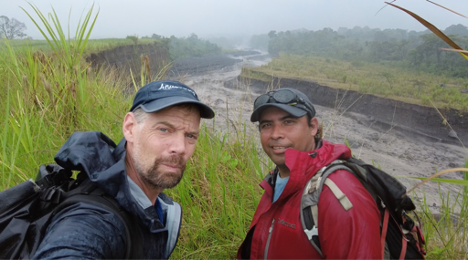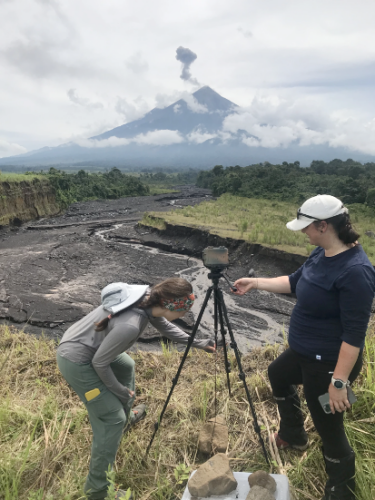
A new study published in Nature Scientific Reports shows that catastrophic volcanic mudflows, known as lahars, can be effectively monitored with infrasound remote sensing technology. Infrasound airwaves are low-frequency sounds below the threshold of human hearing that can propagate long distances such that they may be used to detect small mudflows at distances of five kilometers or more. Interpretation of these infrasonic signals may be used to identify approaching mudflows when they are still more than twenty minutes away.
In terms of the number of fatalities, lahars are the most impactful of volcanic hazards. The 1985 eruption of Nevado del Ruiz (Colombia), for example, was associated with an eruption and killed more than 20,000 people when large lahars reached the flat valleys where the city of Armero was located.
The recent research, “Infrasound Detection of Approaching Lahars”, examined signals from more than twenty small-to-medium-sized lahars that occurred in 2022 acquired at the active Fuego Volcano in Guatemala where regular lahars occur during that country’s rainy season. This study is a collaborative effort by Boise State University, the Instituto Nacional de Sismología, Vulcanología, Meteorología e Hidrología (INSIVUMEH), and Michigan Technological University and funded by the National Science Foundation EAR grants 1914491 and 1914526.
The full study can be read online.
“This study is exciting because it adds to our arsenal of tools for early warning of volcanic mudflows before they reach and potentially impact downstream communities,” said research author and Boise State professor Jeffrey Johnson. “Infrasound signal analysis appears to have special utility to identify the early movement of mudflows high up on a volcano as they begin to flow towards exposed populations. Early warning is key for mitigation of hazards.”
The research team from Boise State was fortunate to record many lahars with their instrumentation and even observe one medium-sized event firsthand (photo support below).
Video of the mudflow and animation of the geophysical signals is available on YouTube.
Co-author Amilcar Roca, of INSIVUMEH in Guatemala, is a senior scientist in Guatemala responsible for interpreting volcano geophysical data. “Our network is used to continuously evaluate the state of volcanic unrest and to provide near real-time bulletins. INSIVUMEH’s monitoring system at Fuego Volcano incorporates a collection of multiparametric sensors and radio telemetry. This includes a permanent infrasound array located about 15 km away from Fuego’s crater and it is the primary tool for characterization of explosive activity. Fuego volcano generates from 250 to 350 explosive events as regular background volcanic activity,” said Roca.

In this study, INISVUMEH’s infrasound array is shown to be effective for monitoring lahars in addition to explosive activity. During the rainy season, lahars are particularly problematic at Fuego because ash and boulders that erupt from the summit vent and have been accumulating over the dry season can be remobilized in violent slurries of mud. These lahars impact roadways and bridges and people who may be working in the many drainages radiating away from Fuego.
More locally, lahar hazards are recognized throughout the U.S. Pacific Northwest including the urban areas near the dormant Mount Rainier. Monitoring efforts by the United States Geological Survey (USGS) at Mount Rainier are ongoing and incorporate both seismic and infrasonic systems. The recent results published from field efforts at the active Fuego Volcano can now be used to optimize signal processing at Rainier and many other volcanoes worldwide, where lahars present persistent hazards.
“This study will help us to understand the sensitivity of our new infrasound deployments as part of the Rainier Lahar Detection System,” said Wes Thelen, a volcano seismologist with the USGS Cascades Volcano Observatory. “The results here provide relevant case studies for us to calibrate our detection and characterization algorithms.”
Boise State University students were involved in this study including field data collection. Students Jerry Mock and Ashley Bosa share their research recently at the international volcano conference in New Zealand in February 2023. Listen to their experiences about working in Guatemala at Boise State Public radio.